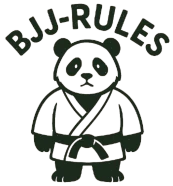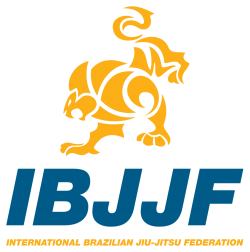Think you can take the quiz directly without reading this first article? Then it’s this way!
If you don’t have 10/10 (25/25 in fact!), we’ll see you in a few minutes!
1/ The authority of the Brazilian Jiu-Jitsu referee:
In Brazilian Jiu-Jitsu (BJJ) rules, the referee is the ultimate authority in a bout (1.1.1) and his decision regarding the outcome of each bout is final and unquestionable (1.1.2).
However, under certain specific circumstances, the outcome of the bout may be changed (1.1.3).
For example:
- If the score was misread
- If the winning athlete used an illegal technique that the referee did not see
- Or if the athlete was disqualified by mistake while using an authorized technique.
If the referee disqualified the athlete by mistake before he/she submitted his/her opponent, the athlete applying the submission will resume the fight in the center of the match area and receive two points.
When the submitted athlete gives up before the interruption and the disqualification, the referee declares the athlete disqualified by mistake as the winner.
If a change in the result is necessary (1.1.4), the referee may consult with the director of refereeing, but the final decision on whether or not to change the result still rests with the referee of the bout.
The Referee Director must consult the central table of the competition to find out about the progress of the bout and can only authorize a change of result if the bout has not yet advanced to the next bout.
2/ The organization of refereeing in Brazilian Jiu-Jitsu:
In a JJB competition, the organizers may decide to appoint three referees for a bout, if necessary (1.2.1).
In this case, two corner referees sit at opposite corners of the match area and exercise the same powers as the central referee.
At least two of the three referees must confirm all points, advantages or penalties awarded.
- If the corner referees agree with the central referee, they must remain seated in their chairs.
- If the central referee and the corner referees disagree, the corner referees must stand up and signal the points, advantages and penalties to be awarded or subtracted using the gestures predefined in the rules.
- The referees will withhold the intermediate decision if there is a disagreement between them on the points awarded for the same movement.
In the case where an athlete accumulates four penalties for a serious fault or lack of fighting spirit, the referee may decide to disqualify him/her by making the gesture corresponding to the serious fault penalty before stopping the bout.
- If at least one of the corner referees also makes this gesture, it confirms the referee’s decision and allows him to stop the bout.
Similarly, if the referee decides to disqualify an athlete for a serious foul, he will make the corresponding gesture before stopping the bout.
- If at least one of the corner referees also makes this gesture, it confirms the referee’s decision and allows him to stop the bout.
Case of a tie between two fighters:
In the event of a tie, the referee will place both athletes in their starting positions, then take two steps back and signal the corner referees to stand up.
After the referees stand up, the center referee will step forward with his right leg, and the three referees will raise their right or left arm to indicate their choice to determine the winner.
The central referee will declare the winner to be the fighter selected by the majority of the three referees.
If necessary (1.2.2), the IBJJF may use two additional referees who have access to video to correct the points, advantages and penalties awarded by the central referee, their decision being final.
3/ The responsibilities of the referee during a Brazilian Jiu-Jitsu competition match:
A- During a Brazilian Jiu-Jitsu (BJJ) fight, the referee has several important responsibilities:
- First, he must call the athletes to the mat to begin the bout (1.3.1).
- Before the start, the referee must perform a final check to ensure that all requirements are met, such as clothing and hygiene (1.3.2).
- During the fight, the referee must place the athletes in the fighting area according to the color of their kimono (1.3.3).
B- To indicate the points of the athletes:
During the fight, the referee must indicate the points awarded to each athlete.
- If the athlete on the right of the referee gets points, the referee must raise his right arm with a yellow and green armband.
- If the athlete on the left of the referee gets points, the referee must raise his left arm without an armband.
C- Kimono colors (1.3.4):
- If both athletes are wearing the same color kimono, the referee places the first athlete on his right and assigns him a yellow and green belt to identify him.
- If one athlete is wearing a white kimono and the other is wearing a royal blue kimono, the athlete with the royal blue kimono must be placed on the right of the referee.
- When one athlete is wearing a black kimono and the other is wearing a royal blue kimono, the athlete with the royal blue kimono must stand to the right of the referee.
- If one athlete is wearing a black kimono and the other is wearing a white kimono, the athlete with the black kimono must stand to the right of the referee.
4/ Refereeing and the fighting area in Brazilian Jiu-jitsu
The referee has several responsibilities during a fight.
First of all, he must start the fight (1.3.5) and intervene if necessary during the fight (1.3.6).
He must also make sure that the athletes remain inside the sparring area and fight correctly (1.3.7).
Exit from the tatami :
- If 2/3 of an athlete’s body is outside the sparring area in a stable position on the ground, the referee must stop the sparring, note the position of the athletes and resume sparring in the center of the sparring area in the same positions.
- When 2/3 of the body of the athletes are outside the sparring area in an unstable position on the ground, (except in the case of an ongoing take-down), the referee will stop the match: the athletes will then restart standing in the center of the tatami.
- If an athlete has achieved a submission hold outside the safety zone, then the referee should not stop the match.
Benefits and points:
- When an athlete is in a submission attempt but the opponent defends himself by moving out of the safety zone, the referee must stop the match and restart it in the center of the combat area with the athletes standing. In this case, if the referee believes that the defending athlete initiated the movement that led to the exit from the combat zone, the referee must signal the addition of 2 points to the score of the athlete who made the submission attempt.
- If an athlete takes his/her opponent into the safe zone while attempting to stabilize a point earning position, the referee must wait for the athlete to stabilize the position for 3 seconds before stopping the match and awarding points. If the athlete maintains the position for 3 seconds, the referee will award the points and restart the athletes standing in the center of the mat.
- The referees must stop any movement of the athletes beyond the safety zone and bring them back to a standing position in the center of the combat area.
- If the bout moves out of the combat area due to the movement of an athlete performing a submission hold, the referee shall not add two points after the bout is stopped. Instead, the referee may give an advantage based on the proximity of the submission hold, following the rules of advantage.
Safety and Sanctions:
It is the duty of referees supervising U12 games to protect the spine of athletes by positioning themselves behind the child when lifted from the ground by the opponent, such as in a triangle or closed guard (1.3.8).
The referee’s duty is to call every penalty, advantage or point scored by each athlete (1.3.9).
It is the referee’s duty to punish and disqualify athletes (1.3.10):
- When an athlete makes an unintentional movement, which places the opponent in an illegal position and no athlete has a submission in progress, the referee must stop the bout and return the athletes to their regular positions. The referee will then restart the bout by punishing the infraction.
- When an athlete makes an unintentional movement, which then places the opponent in an illegal position and an athlete has a submission in progress, the referee will apply the penalty without stopping the bout.
- In the case of a single leg with the head out, for a takedown attempt or any other hold from the ground, with the athletes on their knees or with a sweeping motion, the referee shall act as follows:
-For the youth and white belt divisions, the referee will stop the bout. He will restart the match with both athletes standing. No penalty will be given to either athlete.
-For the other divisions, the referee must not intervene in the match.
Other responsibilities of the referee :
Finally, the referee has several responsibilities during a match (1.3.11 /…/ 1.3.14):
First, he must call medical personnel to the mat if necessary.
Then, he must end the match at the end of the regulation time and announce the result of the match.
Finally, the referee must raise the arm of the winner of the match to designate him as the winner, even if two athletes from the same academy agree on the result.
You can find all these rules in the official ibjjf rules on the ibjjf website!
If you want to play the quiz corresponding to this first article, click here: Refereeing Quiz 1



